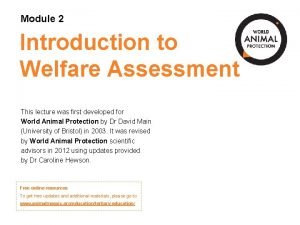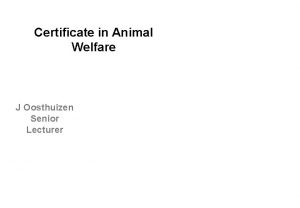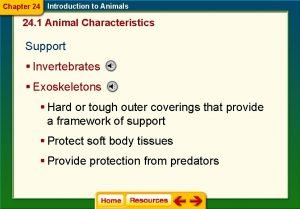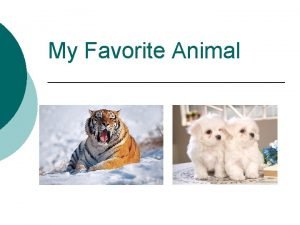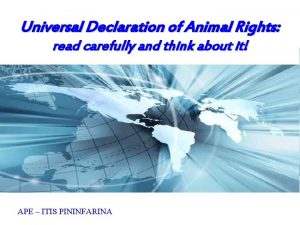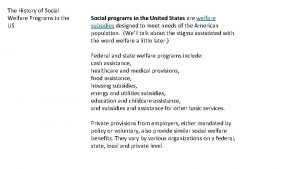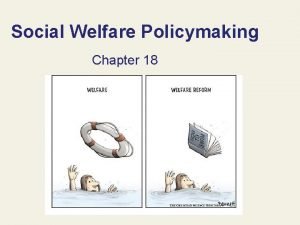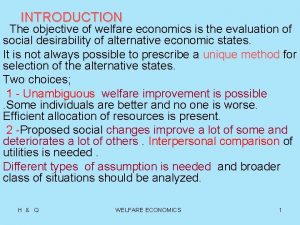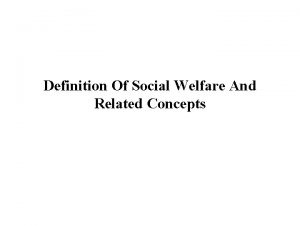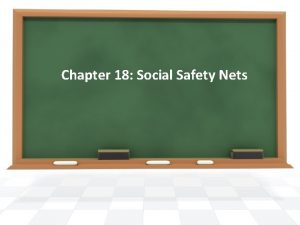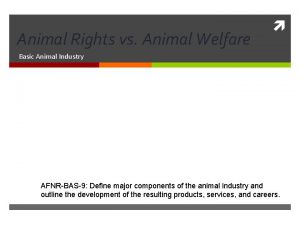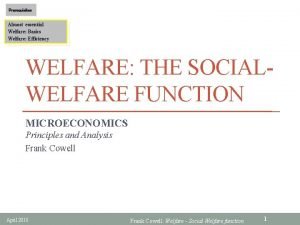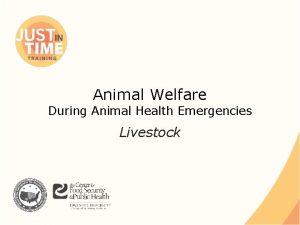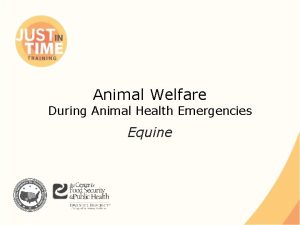Animal Rights Welfare ANIMAL RIGHTS n Animals should















































































- Slides: 79

Animal Rights & Welfare

ANIMAL RIGHTS n. Animals should not be used by humans.

Animal Welfare n If we are to raise or uses animals, then they should be humanely treated. n Given food, water, shelter, health care

is not the same as welfare! n Media often wrongly use the 2 terms interchangeably n Rights

ANIMAL RIGHTS Today There are tens of thousands of animal rights activists and organizations around the world, though relatively few are major players n Came into existence in the 1960 s and 1970 s. n Initially mainly made up of urban people of whom, were vegetarians. n

Beliefs of Most Animal Rights Movement Groups Humanize animals to have same rights as humans (humans are also animals) n To use animals for human purposes is morally and ethically wrong, reflects a bias that humans are superior to animals n Animals should never be used for food, clothing, medical research, and/or product testing. n Animals should not be used for entertainment n Believe in ecoterrorism to prevent people from using animals if necessary n

n Animal Rights is: To end all human "exploitation" of animals - this includes, but is not limited to: ¨ raising and slaughtering of livestock for human or animal consumption ¨ eating meat ¨ Hunting ¨ using animals for medical/veterinary research ¨ Zoos, circuses, rodeos, horseshows, dogshows ¨ animals performing in TV commercials, shows or movies ¨ guide-dogs for the blind ¨ police dogs ¨ search & rescue dogs ¨ and the practice of owning pets

PETA – People for the Ethical Treatment of A nimals n Animal Rights Group n n n Largest group-- 800, 000 members Since 1980, it has been dedicated to establishing and protecting rights of animals. Against eating, wearing, experimenting and using animals for entertainment & kept as pets RADICAL group ¨ Acts of “terrorism” ¨ Controversial campaigns

PETA – People for the Ethical Treatment of A nimals n PETA rakes in nearly $30 million n each year in income, much of it raised from pet owners who think their donations actually help animals PETA is against the no kill movement and euthanizes the majority of animals that are given to them

PETA n In one year, PETA accepted a total of 1877 animals. Then PETA killed 1675. That’s an 89 percent kill rate.

ANIMAL LIBERATION FRONT (ALF) n The Animal Liberation Front (ALF) is a name used internationally by those who, through the means of direct action, oppose the use of animals as property or resources through capitalizing on the destruction and experimentation of animals ¨Includes: n stealing animals from laboratories or fur farms n destroying facilities involved in animal testing and other animal-based industries

ANIMAL LIBERATION FRONT (ALF) n n n ALF is not a group with a membership, but an example of a leaderless resistance. ALF has been described as a domestic terrorist threat in the UK, and in January 2005, it was named as a terrorist threat by the United States Department of Homeland Security. Placing homemade bombs on doorsteps, raiding laboratories, destroying facitilies, setting farm animals “free” (to be run over or die without proper feed/care), etc…

The Humane Society of the United States (HSUS) n n The largest US animal rights group, with a budget of around $100 million per year. HSUS is often seen as an umbrella group for local humane societies, despite less than 10% of their budget going to local shelters. Most of their money is spent fighting their cause in the political arena. HSUS Donations Scandal

Other Animal Welfare groups American Humane Association n Animal Legal Defense Fund n Best Friends Animal Society n Humane Research Council n Alliance for Animals n Friends of Animals n

So the difference is…. n While Animals Rights Advocates and Groups talk about humane care, the bottom line is to work for humane care and legislation ONLY until all animals can be removed from human use. The reason for this is the Animal Rights belief that no species on this planet is better than another; therefore, humans have no right to dominate over, use, breed, or eat non-human species.

Important Dates and Acts of Legislation associated with animal welfare…. 1641 The bodies of Liberty-- to protect farm animals from cruel treatment. the 1 st laws on the books

1828 1 st anticruelty act passed by the New York legislature. 1866 ASPCA was formed. American Society for the Prevention of Cruelty to Animals

1906 Animal Transportation Act — limits distance traveled without food & water 1958 Humane Slaughter Act— all animals must be rendered unconscious before bleeding/sticking

1966 - Public Law 89 -544 Laboratory Animal Welfare Act (AWA) — insure the humane care and treatment of dogs, cats and certain other animals used for research, experimentation, exhibition and sale purposes • Exceptions – mice, rats, and birds used in research 1976 Horse Protection Act - wild horses, mustangs can not be slaughtered

Animal Research n n Animal testing or animal research refers to the use of animals in experiments. 17 -23 million animals are used in the United States for research every year. About 95% are rats and mice specifically bred for research Over 10 times more animals are used by humans for other purposes (agriculture, food, hunting, pest control) than are used in animal testing 1 million animals a day are hit by vehicles.

Animal Research n n ~$45 billion is spent in the United States for biomedical research every year By comparison, Americans spend ~ $1. 5 billion on health care, In other words, for every $ spent on health care, three and a half cents were spent on research. Scientists are pleased that the small investment in animal research yields improved treatments and cures that save money. But far more rewarding is the knowledge that animal research saves lives. http: //www. fbresearch. org/

Animal Research The earliest references to animal testing are found in the writings of the Greeks in the second and fourth centuries BC. n Insulin was first isolated from dogs in 1922, and revolutionized the treatment of diabetes n

Animal Research "Animal research has played a vital role in virtually every major medical advance of the last century. " – Foundation for Biomedical Research

Animal Research scientists and governments say that animal testing should cause as little suffering to animals as possible, and that animal tests should only be performed where necessary. n The “Three Rs" are guiding principles for the use of animals in research in many countries: n

Animal Research n n n Reduction refers to methods that enable researchers to obtain comparable levels of information from fewer animals, or to obtain more information from the same number of animals. Replacement refers to the preferred use of nonanimal methods over animal methods whenever it is possible to achieve the same scientific aim. Refinement refers to methods that alleviate or minimize potential pain, suffering or distress, and enhance animal welfare for the animals still used.

Animal Research n According to the 2000 USDA Annual Report: ¨ 63% of animals experienced slight or momentary pain, such as an injection. ¨ 29% of the research procedures employed anesthesia and postoperative painkillers. ¨ 7% of the procedures, neither anesthesia nor pain medication could be used, as they would have interfered with research results. However, when this is the case, pain is minimized as much as possible.

Guide for the Care and Use of Laboratory Animals Provides guidelines and references for establishment and maintenance of effective programs and facilities for animal research n Widely accepted as the primary reference for animal care and use n

Responsible Pet Ownership What does it take

n Being a responsible pet owner is much more than just providing adequate water, food and shelter for your pet. Domestic pets are completely dependent on their owners for their welfare. n Owning a pet is a lifetime commitment.

before getting a pet consider: n n n Getting a pet should never be an impulse decision. Careful research and planning are essential. ANIMALS ARE NOT DISPOSABLE! Animals are thinking, feeling creatures. They bond deeply with their families, and they deserve the same devotion from you. ¨ Bringing a pet into your home should be a life-long commitment, which can easily be 10 -15 years.

before getting a pet consider: n Prepare for costs associated with basic and emergency veterinary care, quality food, and supplies.

before getting a pet consider: n Where you get the animal from? Shelter? Breeder? Rescue? Pet store? Puppy Mill?

Before getting a pet consider: n Educate yourself about pet care before you adopt. Responsibilities such as feeding and bathing, cleaning up feces, and walking/exercise are all part of caring for your pet.

n Take some time to understand dog behavior and develop realistic expectations. Many books and videos are available on the subject.

n Train your pet ¨ Dog obedience classes ¨ Puppy classes n Offered at local pet stores and training centers

Grooming is essential

Teamworks Dog Training Mission statement "Train with your mind, not your might, with understanding, not anger" Teamworks Dog Training n n At Teamworks, we feel very strongly that a successful relationship is created between dog and human by building trust and mutual understanding. We believe in and use humane training methods that enhance the communication between handler and dog. We teach our classes using positive-reinforcement based training and encourage the use of humane "people empowering" techniques in our classes. We do not use or tolerate harsh and inhumane punishment-based methods, as we feel that this type of punishment breaks down the relationship between dog and handler and in itself, escalates aggression.

before adopting consider: n Don't be guilty of "dog storage" by leaving your dog in the back yard 24 hours/day. Exercise your dog daily and make him/her your companion.

Why? n n Tethering is both inhumane and a threat to the safety of the confined dog, other animals and humans. In many cases, the necks of chained dogs become raw and covered with sores, the result of improperly fitted collars and dogs straining to escape. Some collars become embedded

Why? n n n Dogs are naturally social creatures who thrive on interaction with humans and other animals. A dog kept chained in one spot for hours, days, months or even years suffers from psychological damage. An otherwise friendly and docile dog, when kept chained becomes neurotic, unhappy, anxious and often aggressive

before adopting consider: Choose a pet that fits your lifestyle! n All dogs require daily exercise; however, active dogs require daily rigorous exercise, such as running, or interaction with other dogs. If you are not up to the task, choose a dog with a calmer, less active temperament. n

before adopting consider: n Consider apartment pet restrictions, space, and outside access if you are gone all day. n Pay attention to allergies.

before adopting consider: n Spay or neuter your pets. There are too many homeless animals without adding to the problem.

before adopting consider: n Be aware of weather conditions. Leaving your dog in the car on a hot day or in the yard without shade or water is risking your dog's life.

before adopting consider: n Pet Proof - Make sure your home is "pet" safe. Pesticides, medications, household cleaners and some houseplants can be deadly to your pet. Keep them out of reach.

before adopting consider: n Keep identification tag on your pet. . . it is your pets ticket back home. ¨Both dogs and cats need ID!! Microchipping is good too, but an external tag is essential, it could mean the difference of your neighbor returning your pet to you or turning him into the pound!

before adopting consider: n Veterinary Costs ¨ Puppies & Kittens will need to go to the vet 3 -4 times to get all vaccinations, fecal sample, blood draw, and spay/neuter. ¨ This can add up to $1000 depending on animal and veterinary hospital. ¨ If your animal has medical issues, genetic disorder, or gets sick that is more $$

before adopting consider: n Vaccines are necessary ¨ Prevents your animal from getting sick, spreading disease/parasites to other animals & humans ¨ Rabies is required, other vaccines are required depending on county. ¨ Many towns/county require your dog to be registered with evidence of Rabies vaccine.

Clinics n Petco, Petsmart, and Tractor Supply Company offer clinics for vaccines and microchips

before getting a pet consider: n Pet Insurance ¨ Variety of plans ¨ Cover vaccines, spay/neuter, illness ¨ Hereditary conditions ¨ Chronic illness ¨ Accidents & injury ¨ Etc…

Microchips n n Cost $20 -$75 A microchip implant is placed under the skin of an animal. The chips are about the size of a large grain of rice and are based on a passive RFID (Radio Frequency Identification) technology.

before getting a pet consider: Obedience train and socialize your animal. n Don't let your pets run loose. Dogs should be walked leashes. Any outdoor off leash access should be secure in a fenced area. An outdoor cats average lifespan is 3 years, an indoor cat's average lifespan is 14 years. n

before getting a pet consider: Provide your pet the proper diet. Obesity can be as deadly as malnutrition. Be aware that some foods can be deadly, such as chocolate, grapes/raisins and fatty foods can cause pancreatitis. n Make sure your pet gets proper amount of exercise. n

Pet Overpopulation


Spay/Neuter Myths & Facts

Myths… 1. My pet will get fat and lazy ¨ FACT: The truth is that most pets get fat and lazy because their owners feed them too much and don't give them enough exercise. 2. It’s better to have one litter first ¨ Medical evidence indicates just the opposite. In fact, the evidence shows that females spayed before their first heat are typically healthier. Many veterinarians now sterilize dogs and cats as young as eight weeks of age.

Myths… 3. My children should experience the miracle of birth n Even if children are able to see a pet give birth —which is unlikely, since it usually occurs at night and in seclusion—the lesson they will really learn is that animals can be created and discarded as it suits adults. Instead, it should be explained to children that the real miracle is life and that preventing the birth of some pets can save the lives of others.

Myths…. 4. But my pet is a purebred ¨ Congratulations - So is at least one out of every four pets brought to animal shelters around the country. There are just too many dogs and cats— mixed breed and purebred

Myths…. 5. I don't want my male dog or cat to feel like less of a male. ¨ FACT: Pets don't have any concept of sexual identity or ego. Neutering will not change a pet's basic personality. He doesn't suffer any kind of emotional reaction or identity crisis when neutered.

Myths…. 6. It’s too expensive to have my pet spayed or neutered ¨ ¨ ¨ Owning a pet does require spending $$$ The cost of spaying or neutering depends on the sex, size, and age of the pet, your veterinarian's fees, and a number of other variables. But whatever the actual price, spay or neuter surgery is a onetime cost—a relatively small cost when compared to all the benefits. It's a bargain compared to the cost of having a litter and ensuring the health of the mother and litter; two months of pregnancy and another two months until the litter is weaned can add up to significant veterinary bills and food costs if complications develop. Most importantly, it's a very small price to pay for the health of your pet and the prevention of the births of more unwanted pets. There are reduced fee programs available (SPCA)

Low cost Spay/Neuter Programs n http: //berkshirehumane. org/program/low-costspayneuter/ ¨ Cat Snip $50 ¨ Grants – apply directly to humane society ¨ Animal Dreams ¨ SNAP (Spay/Neuter Assistance Program) ¨ Massanimalfund. com Most programs also offer low cost/free vaccinations

Myths…. 7. I’ll find good homes for all the puppies or kittens ¨ You may find homes for all of your pet's litter. But each home you find means one less home for the dogs and cats in shelters who need good homes. ¨ How do you know that each home will be committed to keeping the animal for it’s entire life – “A Forever Home” ¨ Also, in less than one year's time, each of your pet's offspring may have his or her own litter, adding even more animals to the population. The problem of pet overpopulation is created and perpetuated one litter at a time.

Too many animals, not enough homes Every day 10, 000 humans are born and 70, 000 cats and dogs are born n In order to end the homelessness of cats and dogs, each man, woman and child would need to adopt 7 animals each n

Pet Overpopulation Every year, between 6 and 8 million dogs and cats enter U. S. shelters; and half of them are euthanized because there are not enough homes for them. n Too many companion animals competing for too few good homes is the most obvious consequence of uncontrolled breeding n

Pet Overpopulation n n Every day in the United States, thousands upon thousands of puppies and kittens are born because of the uncontrolled breeding of pets. Add to that number the offspring of stray and abandoned companion animals, and the total becomes even more staggering.

Pet Overpopulation n Communities are forced to spend millions of taxpayer dollars trying to cope with the consequences of this surplus of pets. These public costs include services such as investigating animal cruelty, humanely capturing stray animals, sheltering lost and homeless animals and the costs associated with euthanizing and disposing their bodies.

The Solution n Education is an essential part of solving this problem. Unless people know the facts about pet overpopulation and sterilization, they are virtually helpless to do anything about the problem. n Reduced spay/neuter fees play an important role as well n Pet owners can do their part by having their companion animals spayed or neutered. This is the single most important step you can take. ¨ Have your pet sterilized so that he or she does not contribute to the pet overpopulation problem, and adopt your next pet from an animal shelter/rescue

The Solution n Only by implementing widespread sterilization programs, only by spaying and neutering companion animals, and increasing education and awareness about spaying and neutering. ¨ In seven years, 1 female cat and her offspring can theoretically produce 420, 000 cats ¨ Given these high reproductive rates, carefully planned and implemented sterilization programs could produce a dramatic reduction in the number of unwanted companion animals born. ¨ In fact, in those towns and cities that have implemented such programs, we've already seen the number of companion animals who had to be euthanized decline by 30 to 60 percent —even in those communities where human populations have been steadily increasing.

Benefits of Spaying & Neutering n n n Healthier pets!!! reducing or eliminating the risk of mammary gland tumors, ovarian and/or uterine cancer, prostate disease, and testicular cancer Reduce the number of unwanted cats and dogs Increase the desire for the pet to stay at home and not roam Reduce aggressive and territorial behavior Increase your bonding time by eliminating the mating behavior – crying and howling incessantly, spraying, attempting to run out the door

Other issues

Breed Specific Legislation “Breed Bans” n n n Regulation of your right to own or, in many cases, not own a dog based solely on the breed or "type“ of dog, not your responsibility as an owner. Target all dogs of a certain breed/type. Guilty AND Innocent. The American Veterinary Medical Association opposes breed-specific legislation

Breed Specific Legislation n Dog problems are generally problems with owner responsibility and are not limited to breeds. When breeds are singled out as dangerous or vicious, responsibility is removed from the dog owner which is where it belongs. Irresponsible people are also less likely to follow the law - and as a result, everyone has to suffer

Breed Specific Legislation Communities that have instituted such bans often find that the irresponsible owners and the criminals who use dogs for illegal purposes simply switch to another breed. n Often dogs are mislabeled and destroyed based on paranoia and prejudice and also punishes those that are good canine citizens n

Alternatives n n Stronger enforcement of existing dangerous dog laws. If they are not already in place - lobby for protection from untrained and unsupervised dogs of any breed or mix. This is a broad-based effort that protects all citizens as any dog can bite and be a nuisance when owned by an irresponsible owner. Those who would deliberately train a dog to act aggressively towards people or other animals, or to use dogs in the commission of a felony or misdemeanor should face additional penalties.

Alternatives Encourage local animal rescue and welfare agencies to provide responsible dog ownership seminars and canine safety education. n Protect the rights of all citizens with nuisance ordinances such as anti-barking, pooper scooper regulations and leash laws. www. animallaw. info www. pbrc. net/breedspecific. html n

Vegetarian vs. Vegan n Vegetarianism is the practice of not consuming the flesh of any animal n Veganism excludes all animal products from diet and in some definitions from attire also, whether or not the production of clothing or items has involved the actual death of an animal (dairy, eggs, honey, wool, silk, down feathers, etc. )

variety of different practices of vegetarianism Foods in the main vegetarian diets Diet Name Meat (includes fish) Eggs Dairy Ovo-lacto vegetarianism Honey No Yes Yes Lacto vegetarianism No No Yes Ovo vegetarianism No Yes Veganism No No

Current issues: 1. Do animals have rights? 2. Should animals be used for food? 3. Should animals be used for experimentation? 4. Should hunting and trapping of animals be allowed? 5. Should animals be used in a classroom? 6. Should animals be kept as pets?
 Difference of animal cell and plant cell
Difference of animal cell and plant cell Plant cell animal cell venn diagram
Plant cell animal cell venn diagram Similarities between animal rights and animal welfare
Similarities between animal rights and animal welfare Welfare rights middlesbrough
Welfare rights middlesbrough Welfare rights salford
Welfare rights salford Welfare rights neath
Welfare rights neath The 5 freedoms animal welfare
The 5 freedoms animal welfare Higher certificate in animal welfare
Higher certificate in animal welfare Animal welfare bulgaria
Animal welfare bulgaria Https://a-z-animals.com/
Https://a-z-animals.com/ Consumer producer decomposer
Consumer producer decomposer Detritus food chain
Detritus food chain Animals that eat both plants and animals
Animals that eat both plants and animals Negative rights vs positive rights
Negative rights vs positive rights Littoral vs riparian rights
Littoral vs riparian rights Conclusion of rights
Conclusion of rights Legal rights and moral rights
Legal rights and moral rights What is negative right
What is negative right Negative rights vs positive rights
Negative rights vs positive rights Rosalind hursthouse
Rosalind hursthouse Negative right
Negative right Lesson 2: animal body plans: 1 biology b unit 3: animals
Lesson 2: animal body plans: 1 biology b unit 3: animals Lesson 2: animal body plans: 1 biology b unit 3: animals
Lesson 2: animal body plans: 1 biology b unit 3: animals Aare tool
Aare tool Chapter 24 section 1 animal characteristics
Chapter 24 section 1 animal characteristics Brainstorming warm up
Brainstorming warm up Aristotle animal rights
Aristotle animal rights The universal declaration of animal rights
The universal declaration of animal rights What is welfare
What is welfare What is welfare
What is welfare Cdm welfare facilities
Cdm welfare facilities Welfare economics examples
Welfare economics examples Monopoly deadweight loss
Monopoly deadweight loss Voluntary health and welfare organization examples
Voluntary health and welfare organization examples Tijana sukilovic
Tijana sukilovic Social programs in the us
Social programs in the us Social welfare vs social work
Social welfare vs social work Examples of social welfare programs
Examples of social welfare programs What is industrial achievement-performance model
What is industrial achievement-performance model Lta welfare officer poster
Lta welfare officer poster Guardian delta
Guardian delta National program for child health
National program for child health National policy and legislation
National policy and legislation Deadweight loss monopoly graph
Deadweight loss monopoly graph What is welfare
What is welfare Social group work models
Social group work models Objectives of welfare economics
Objectives of welfare economics Economic welfare adalah
Economic welfare adalah Economic welfare
Economic welfare What is welfare
What is welfare International welfare agencies
International welfare agencies Council for the welfare of children
Council for the welfare of children Welfare effects of monopoly
Welfare effects of monopoly Pros and cons of welfare
Pros and cons of welfare Welfare effects of monopoly
Welfare effects of monopoly Classification of labour welfare
Classification of labour welfare Agencies related to welfare services to the child
Agencies related to welfare services to the child National agencies related to child welfare
National agencies related to child welfare Afm welfare
Afm welfare Premipension
Premipension Republic act 9344 juvenile justice and welfare act of 2006
Republic act 9344 juvenile justice and welfare act of 2006 Psc cuny welfare fund vision
Psc cuny welfare fund vision Welfare management system
Welfare management system Welfare solutions
Welfare solutions Models of social welfare
Models of social welfare Cpi care welfare safety security
Cpi care welfare safety security Conclusion of social welfare
Conclusion of social welfare Father of welfare economics
Father of welfare economics 2nd social welfare policy in pakistan
2nd social welfare policy in pakistan District integrated health and family welfare society
District integrated health and family welfare society _____ is unselfish regard for the welfare of others.
_____ is unselfish regard for the welfare of others. Your welfare is our responsibility
Your welfare is our responsibility Child welfare services
Child welfare services Acs dobfar welfare
Acs dobfar welfare Education welfare officer northern ireland
Education welfare officer northern ireland Central child welfare board
Central child welfare board Welfare benefits unit
Welfare benefits unit Microbes in human welfare
Microbes in human welfare Agriculture cooperation and farmers welfare
Agriculture cooperation and farmers welfare Adoption assessor training ohio
Adoption assessor training ohio






